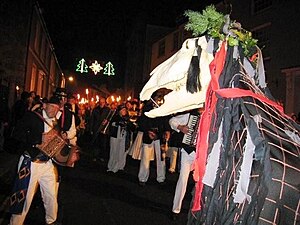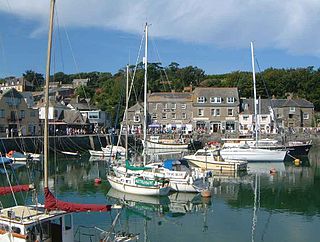
Padstow is a town, civil parish and fishing port on the north coast of Cornwall, England, United Kingdom. The town is situated on the west bank of the River Camel estuary, approximately 5 miles (8.0 km) northwest of Wadebridge, 10 miles (16 km) northwest of Bodmin and 10 miles (16 km) northeast of Newquay. The population of Padstow civil parish was 3,162 in the 2001 census, reducing to 2,993 at the 2011 census. In addition an electoral ward with the same name exists but extends as far as Trevose Head. The population for this ward is 4,434.

Penzance is a town, civil parish and port in the Penwith district of Cornwall, England, United Kingdom. It is the westernmost major town in Cornwall and is about 64 miles (103 km) west-southwest of Plymouth and 255 miles (410 km) west-southwest of London. Situated in the shelter of Mount's Bay, the town faces south-east onto the English Channel, is bordered to the west by the fishing port of Newlyn, to the north by the civil parish of Madron and to the east by the civil parish of Ludgvan. The civil parish includes the town of Newlyn and the villages of Mousehole, Paul, Gulval, and Heamoor. Granted various royal charters from 1512 onwards and incorporated on 9 May 1614, it has a population of 21,200.
Cornwall is a Celtic nation with a long musical history. Strengthened by a series of 20th century revivals, traditional folk music has a popular following. It is accompanied by traditions of pipers, brass and silver bands, male voice choirs, classical, electronic and popular music.
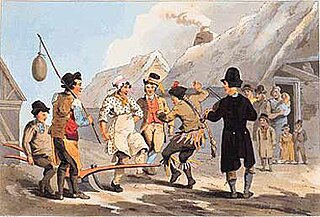
Plough Monday is the traditional start of the English agricultural year. Plough Monday is the first Monday after Epiphany, 6 January. References to Plough Monday date back to the late 15th century. The day before Plough Monday is referred to as Plough Sunday, in which a ploughshare is brought into the local Christian church with prayers for the blessing of human labour, tools, as well as the land.

Golowan is the Cornish language word for the Midsummer celebrations in Cornwall, UK; they were widespread prior to the late 19th century and most popular in the Penwith area and in particular in Penzance. The celebrations began on St John's Eve with bonfires, fireworks, dancing and music, followed by a fair around the town quay on Midsummer Day and were repeated on St Peter's Eve and St Peter's Day.

Madron is a civil parish and village in west Cornwall, England, United Kingdom. Madron is named after Saint Madern's Church. Its annual Trafalgar Service commemorating the death of Vice Admiral Horatio Nelson was started on 27 October 1946, following a local tradition that his death was first announced on British soil in the Union Hotel, Penzance.
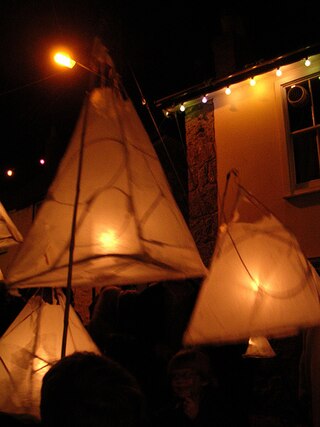
Tom Bawcock's Eve is an annual festival, held on 23 December, in Mousehole, Cornwall.
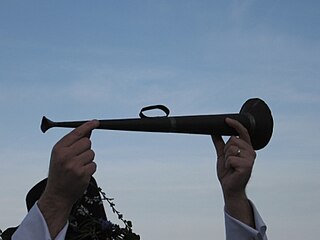
The West Cornwall May Day celebrations are an example of folk practices found in the western part of Cornwall, England, United Kingdom, associated with the coming of spring. The celebration of May Day is a common motif throughout Europe and beyond. In Cornwall there are a number of notable examples of this practice including the Obby Oss in Padstow and Furry Dance or Flora day in Helston. The celebrations are in contrast to the Cornish midwinter celebrations that occur every year such as the Penzance Montol Festival and the Padstow Mummer's Day festival.
Cornish dance originates from Cornwall, UK. It has largely been shaped by the Cornish people and the industries they worked in. In most cases, particularly with the step dancing, the dances were still being performed across the region when they were collected.
The serpent dance is a traditional Cornish dance associated with the Midsummer festival of Golowan and Cornish cultural events such as nos lowen.
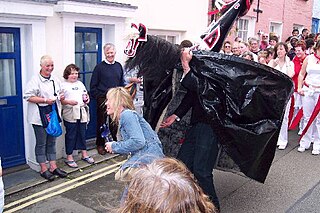
The 'Obby 'Oss festival is a folk custom that takes place each 1st of May in Padstow, a coastal town in North Cornwall. It involves two separate processions making their way around the town, each containing an eponymous hobby horse known as the 'Obby 'Oss.
Margaret Ann Courtney was a Cornish poet and folklorist based in Penzance, Cornwall.
Nickanan Night is a Cornish feast, traditionally held during Shrovetide, specifically on Shrove Monday.

Saint Piran's Day, or the Feast of Saint Piran, is the national day of Cornwall, held on 5 March every year. The day is named after one of the patron saints of Cornwall, Saint Piran, who is also the patron saint of tin miners.
The Montol Festival is an annual festival in Penzance, Cornwall, England, United Kingdom, which has been held on 21 December each year since 2007. The festival is a revival or reinterpretation of many of the traditional Cornish midwinter customs & Christmas traditions formerly practiced in and around the Penzance area and common to much of Cornwall at one point. The festival spans several days, but the main events are held on the traditional date of the feast of St Thomas the Apostle, usually 21 December, which always coincides with the winter solstice.
Mummer's Day, or "Darkie Day" as it is sometimes known, is a traditional Cornish midwinter celebration that occurs every year on Boxing Day and New Year's Day in Padstow, Cornwall. It was originally part of the pagan heritage of midwinter celebrations that were regularly celebrated throughout Cornwall where people would take part in the traditional custom of guise dancing, which involves disguising themselves by painting their faces black or wearing masks.

In folklore, a hobby horse is a costumed character that features in some traditional seasonal customs, processions and similar observances around the world. In England, they are particularly associated with May Day celebrations, mummers' plays and the Morris dance.
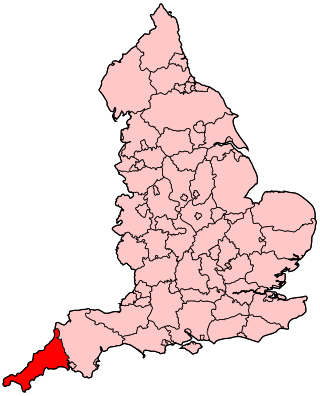
The following outline is provided as an overview of and topical guide to Cornwall: Cornwall – ceremonial county and unitary authority area of England within the United Kingdom. Cornwall is a peninsula bordered to the north and west by the Celtic Sea, to the south by the English Channel, and to the east by the county of Devon, over the River Tamar. Cornwall is also a royal duchy of the United Kingdom. It has an estimated population of half a million and it has its own distinctive history and culture.
Presented below is an alphabetical index of articles related to Cornwall:
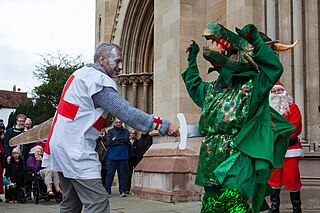
Mummers' plays are folk plays performed by troupes of amateur actors, traditionally all male, known as mummers or guisers. Historically, mummers' plays consisted of informal groups of costumed community members that visited from house to house on various holidays. Today the term refers especially to a play in which a number of characters are called on stage, two of whom engage in a combat, the loser being revived by a doctor character. This play is sometimes found associated with a sword dance though both also exist in Britain independently.
